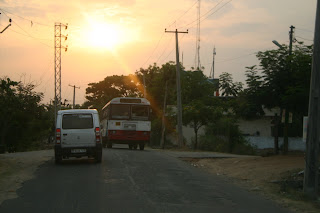Warning: this post has graphic pictures/deals with a rather graphic content so if you don't want to read be warned.
So today we visited with our partner LEPRA. They are an organization who has worked with leprosy for the past 87 years. They began under the British and have evolved into their current organization today. In addition to working with leprosy, they are a research and aid organization that works with HIV/AIDS, malaria and tuberculosis.
Their aim
So we went inside their clinic and listened to the head doctor and learned about a few of the patients.
This is the clinic we went to
sitting listening to the doctor
Here is the doctor telling us about this woman. She came in with a cough that wouldn't go away. When they took her blood for cultures, they found out that not only did she have Tuberculosis, but she also had HIV. The sad thing was is that she had probably gotten it from her husband who had cheated, but when he found out he left her and then died because of the disease as well. She is now alone with 2 small children. Her TB is now gone, but she will live with HIV for the rest of her life. The sad thing about this case is that it is quite common for HIV patients to come down with TB. It is an opportunistic disease and is a common way for patients to find out that they have HIV.
After learning about this woman we heard about a few other TB patients. There was a woman who had started taking the medicine but then stopped before full term and as a result it came back with a drug-resistant strain. She now has to take a 7-series medicine for 18 months instead of the 1 series for 3 months. Also she passed that strain onto her daughter so she also has to take that medicine as well.
Then the doctor took us back into a room to show us what TB looked like under the microscope and show us the medicines.
Tuberculosis under a microscope
The doctor showing us medicines
storage of medicines
After this they started to show us their treatments for leprosy. It involved various things such as medication, self-care and shoes.
The shoes are made of a special microcellular rubber which helps distribute weight. One of the main problems with leprosy is that you lose feeling/cannot feel pain. This can cause problems with shifting weight from one leg to another and other problems. The shoes help to distribute the weight and protect their feet from lesions.
The man who makes the shoes
A doctor letting us feel it and showing us the microcellular rubber
This is a picture of the leprosy patients learning how to do self-care. They need to soak their feet in water and a certain type of oil to help prevent their feet from cracking since their feet don't sweat. It also can help protect their feet from lesions and ulcers that can result from this lack of no pain and therefore stepping on hot things or glass, etc.
This woman has an advanced stage of leprosy which I didn't realize could cause cataracts.
Here a doctor is cleaning a woman's foot after doing the soaking treatment. She lost three of her toes because of not being able to feel pain and the ulcers.
This woman also has leprosy and as a result has also developed elephantiasis. This is another pairing that I didn't know was common. Both diseases are so rare in the United States that it was interesting to see them in person. She was very friendly though and kept smiling at us and saying 'namaste.'
We then explored a little bit outside and it was funny because a cow randomly decided to come into the yard. Cows are EVERYWHERE here. And they're all well taken care of because they're seen as holy.
I love this picture, everyone is smiling. :)
After going to the clinic, we went to the research facility a little further out from the city.
They fed us some awesome food. Not quite sure what everything was. It's been fun with the food situation because at first the food was super spicy and now we're used to it.
Mmm good
My plate
Brandon showing how most people eat here
The grounds were absolutely gorgeous.
So pretty.
Hibiscus flowers growing on the grounds
After eating they brought us into the facility where they showed us some of the different facilities. They showed us slides of leprosy and TB and took us upstairs to the labs where the Ph.D students were working on decoding different aspects of HIV, TB and Leprosy.
Us looking at slides of TB and Leprosy
Julie and Ale
It's an eye chart in Telegu! (The local language)
I thought this was a rather interesting condom promotion ad to prevent HIV....
So it was a lot of information for one day and one partner but very informative. I learned a lot of different things about TB and Leprosy.
On the ride back it was like a 45 minute ride so I took some pictures since I was sitting in the front.
Cool sun shot
These kids were cute
This is so common.
What an eventful day. I'm starting to get to the point where I'm recognizing where I am. It's a nice feeling to start to belong.
I'm starting to love India. :)
Wednesday, May 18, 2011
Lepra!
Labels:
HELP International,
HIV/AIDS,
Hyderabad,
India,
LEPRA,
leprosy,
Partners,
tuberculosis
Subscribe to:
Post Comments (Atom)




























0 comments:
Post a Comment